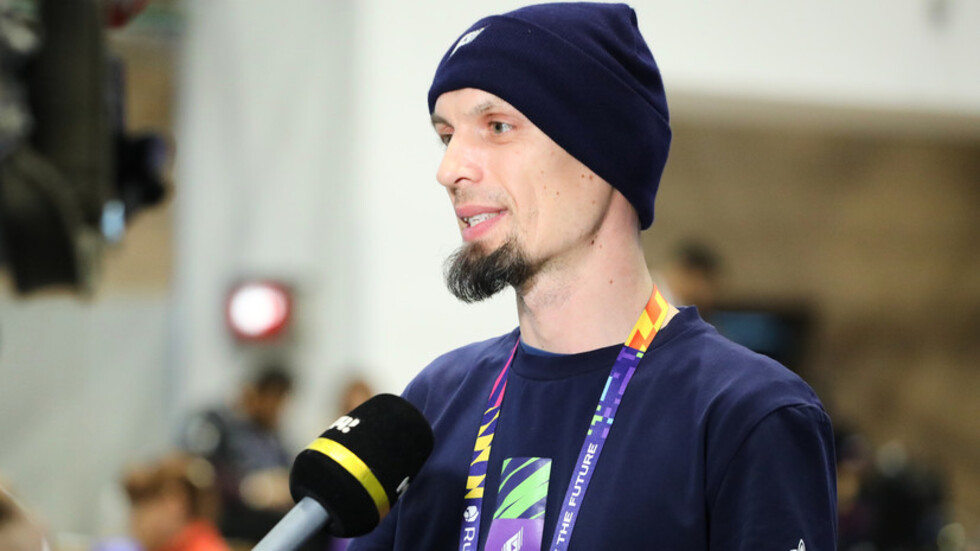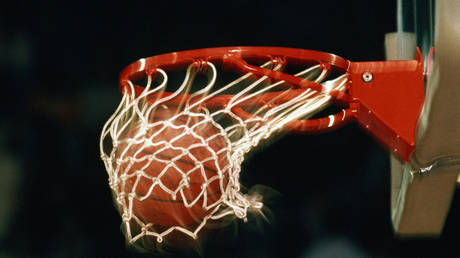
‘The most important thing is to accept yourself’ – cybathlete Bachu on prosthetic hands and the Games of the Future in Kazan


After 18 years of life without hands, it is difficult to get used to bioelectric limbs, especially when doing everyday chores, RT was told by prosthesis tester Sergey Bachu, who lost both hands as a teenager after an electrical accident. He also shared how he had coped with depression after amputations, described his meeting with Roman Kostomarov and explained why it was important to include cybathletics (a discipline where physically-challenged athletes perform with the assistance of technology) in the Games of the Future program.
How to live with prostheses
– Did it take a long time to get used to prostheses?
– The biggest challenge is to relearn how tp do chores. I still don’t use prostheses in my everyday life. I have adapted to life without them in the 18 years since the accident: I cook, clean and dress myself. For example, to sign my name, I have to get the pen into the prosthesis correctly, which takes five to 30 seconds. I often took my prostheses off when I needed to do things I already knew how to do. And I set myself the task of learning how to use them. I can already do a lot of things, but I can’t use cutlery yet because of the specifics of my injury.
– What kind of meals do you cook for yourself?
– Practically all the basics. For example, once I cooked pilaf, and, according to my wife, it turned out better than hers. Since then, I'm the one cooking pilaf.
– So, getting an egg out of boiling water is no problem for you. What other things can you boast about that most people can’t do?
– I haven’t given it much thought. For example, in extreme conditions, prosthetic limbs do not get cold. I climbed Mount Elbrus with them; I didn’t make it to the top, however, and pulled out at an altitude of 4,300 meters. In fact, you don't need artificial hands there, your legs are doing all the work. But I took prostheses with me to see how they would behave and how comfortable it would be for me in such conditions. In terms of performance, the prostheses proved to be fine.
– Is there a difference between lifting an apple and a brick? Do you feel the weight?
– Naturally! The prosthesis attaches to the human body. The entire weight is placed at the point of contact. The heavier the object, the more you will feel the prosthesis. If you walk around with it from morning to evening, then you will feel tired and uncomfortable in the evening. It is like wearing heavy shoes on your feet.
– Have you tested how much weight you can lift?
– I tested the mechanics of the prosthesis: I lifted a 19-liter bottle of water about 15-20 centimeters, and the prosthesis bore it right and worked well.
– What kind of prostheses are there?
– There are three main types. The first is cosmetic, which simply an imitation of the hand. It does not have any functionality. The second is traction, or mechanical, which uses movements of the wrist or elbow joints of the user. That is, the person bends the joint, the mechanism is stretched and puts the fingers in motion, and the prosthesis grips. The third type is bioelectric. This is a more complex mechanism that works on muscle micropulses, which are amplified and transmitted to the motors.
Bioelectric prostheses, in turn, are divided into two types: single-grip and multi-grip. In the first case, the four fingers are always in the same position, and one finger moves separately from them. The hand opens and closes. In a multi-grip, the fingers can independently move in different directions. The hand is pre-programmed for the different grips that the user needs. Bioelectric prosthesis are the heaviest, children will have a hard time with them. Not even all adults are comfortable with this weight all day long. There are people who are used to the traction ones, they are simpler and lighter. Children use them very actively.
– What kind do you use?
– For me, the most optimal is the single-grip. It suits my purposes. When you have one hand, you’d perform most tasks with your good hand, and sometimes help yourself with a prosthesis. But when both your hands are missing, all the burden is on the prostheses. I have a double amputation, so the focus is on functionality. As of now, the single-grip is superior to multi-grip in everyday life. However, it cannot be evolved anymore. That is why with time the other type will become more functional. This is what we, the users, are looking forward to.
– How are prostheses serviced?
– On an as-needed basis. If a prosthesis is working properly, you do not need to do anything to it. Naturally, it must be used according to the instructions. Do not subject it to heavy loads, do not drop it, do not hit it on hard objects. The prosthesis is designed for three years of use, then it must be replaced. The battery needs to charged once a day.
Emotional state
– After the injury, you were depressed for a long time. What were your thoughts at that time?
– It was 1999, a village in Moldova, an extremely difficult situation, because at the age of 14 your personality is just starting to form. Boys begin to get interested in girls. Nowadays you can read something, find people who found themselves in similar situations, and be inspired by their stories. Back then, I had no such thing to lean on. I lived without even thinking about the world outside my village.
Naturally, there were a lot of household chores, I had to work with my hands. That’s why everyone around me treated me with pity. And I thought the same way, I didn’t see any way out, because I didn’t even dream about prostheses. I knew they were very expensive. Gradually I became depressed and even thought about suicide. At the age of 18, I made a suicide attempt. It was unsuccessful, so the psychological problems only worsened. I had no hope for changes for the better.
 ‘It’s like Wimbledon’: Games of the Future boss shares numbers and plans for next tournaments
‘It’s like Wimbledon’: Games of the Future boss shares numbers and plans for next tournaments
– How did you overcome depression in the end?
– I met people who treated me as a full individual. Without pity, as an equal. According to them, I was mentally different from the rest of the villagers. They said, loosely speaking, that everyone was generic and drab, and I was special. Thanks to these words and these people, I changed my own attitude towards myself. After a couple of years, I gradually started to come out of my depression, went to university, graduated and started to take a brighter view of life, trying to change it.
I think my depression lasted about six years. It is very difficult for a person to be so depressed for such a long time. I was even irritated by the mere act of eating.
– What should be the rehabilitation program after limb loss?
– First of all, it is psychological treatment. A whole team is needed to show the person that he can be helped. The support of relatives is very important, and it is the anchor. If relatives treat a person with pity, it is unlikely that he will treat himself differently.
– What advice can you give to those who have faced a similar situation?
– We should remember that anything will have an end to it. Our life zigzags, up and down. If a person is missing a limb, it is not the worst thing in life. You are alive, which is already good, and you can work with it, you can live an interesting life. I remember meeting a young lady at a cybathletics competition, and she was very enthusiastic about her diving.
It’s nice to be in the company of someone who has a job, a family, and hobbies; the lifestyle of such a person is more interesting than that of most average people. It’s uplifting. There are many people who are physically healthy, but mentally they feel incomplete. Because of this, they can be depressed for a long time, cannot sort themselves out. This is not a matter of having limbs.
– Are there any communities of cyborg people in Russia? Where can people get moral support?
– Our company (Motorika, a manufacturer of bionic prostheses. – RT) has several chat rooms, both for adults and children. There is a community of people with disabilities in St. Petersburg. They invent activities for themselves, organize canoe rafting, parachute jumps. It is unlikely to change life dramatically, but it gives support and understanding that people can have fun together, share experiences and simply communicate with those who can understand or advise.
– What is society’s attitude towards cyborg humans?
– Our media are now more actively covering the subject. Movies and shows are appearing, where we see that people with special needs can be funny, inspiring, strong and independent. Many people realize: in such cases, everything depends on the person’s identity, not on how he or she looks or what physical feature he or she has. Society is gradually changing its attitude from pity to interest and curiosity. More and more often people start wondering how it happened or what such persons do or how this machinery works. Young people like this active interest. They prefer to draw attention to themselves with some brightly colored prosthetics. Adults more often than not do not want to stand out.
Meeting with Kostomarov
– There are not many famous cyborg people in Russia that the media tell us about. The Olympic figure skating champion Roman Kostomarov became such a person relatively recently [having had both his hands and feet amputated because of necrosis after pneumonia complications]. How do you feel about the publicity of this subject?
 Basketball player Shatashvili considers finals with R10 Team USA the jewel of the Games of the Future
Basketball player Shatashvili considers finals with R10 Team USA the jewel of the Games of the Future
– It all depends on Roman’s own desire here. If he wants the attention, that’s fine. But if he wants to relax, and he is being hounded by the media, that’s another matter. The main thing for him is to accept himself as he is and realize that he should just move on with his life. Just like everybody else. He just has a slightly different body, nothing more.
– How familiar are you with his situation?
– I even know him personally. He came to visit us at Motorika, I met him by chance, and we had a little chat.
– What kind of prosthetic hands will fit him?
– It all depends on the level of injury. For example, if the wrist joint is intact, a special prosthesis is required. It is also important to understand what you want from your future limb. There are cases when it is necessary to make a re-amputation, i.e. to remove unnecessary parts that prevent a prosthesis from being fitted. Not everyone is ready to go for such an operation again. They get used to it and think: “Okay, I’ll live on as I am”. Some people are not interested in prosthetics at all, because it wouldn’t meet their expectations.
– Did you give any advice to Roman when you met him?
– I was just sharing my experience. We talked for a few minutes and he was very surprised that I could brush my teeth without prostheses. Prosthetics for hands and feet are very different, because the main task of the feet is to walk. A person learns to walk with prostheses and thus achieves the main goal. This is not the case with prosthetic hands, they only cover about 10-15% of the tasks.
Prosthetics in Russia and abroad
– How developed is prosthetics in our country?
– We are not lagging behind other countries; in some respects, we are even leading. It’s not just about technology, but also about accessibility, which is also important. Because there may be super cool prosthetics, but they are not available to users. Then what is the good of them?
As far as I have heard, in the US and Europe it is difficult to get insurance, but in Russia the terms are very generous, and most people get prosthetics through the public reimbursement program. According to our company’s records, more than 97% of users receive public support.
– What is the cost of prosthetics?
– A traction prosthesis costs about 200,000 rubles (about $2,200) a piece. But think of a child who needs to change the device every year.... A bioelectric single-grip costs 800,000 rubles. A multi-grip, 1-1.5 million rubles and more.
– Are our designs competitive with foreign rivals?
– No other global company can provide such a wide range of prosthetic hands as Motorika. We have eight designs available for different injuries and different needs. Foreign industry leaders can offer two or three models. We also specialize in children’s prosthetics, few companies in the world do this. And this is very important to have a person get used to the peculiarities of his body from childhood and know what a prosthesis is.
– What needs to be done to improve the availability of prostheses in Russia?
– At the moment it is difficult to make a difference, components are expensive. But we need to develop a culture of prosthetics. Many people don’t believe in it. Only 14% of people with similar injuries use prosthetics.
– The number of people in need of prosthetics is growing in the country. Will the industry be able to meet the growing demand?
– It can with the support of the state. We need effective institutions that will help in removing red tape.
– How can a person become a prosthetics tester?
– Apply to a company that produces prosthetic limbs. If a person is ready to do what the developers need, they can work together.
– When will prosthetics be able to replicate 100% of all the functions of an arm or leg?
– A prosthetic limb, under some conditions, even surpasses the capabilities of a human hand. Perhaps people will start to think what is more beneficial, to have a real limb or an artificial one. I believe that over the 20-year horizon we will see huge breakthroughs. Society will be different, but we should avoid exhausting the planet’s resources.
– Your advice to those who had an amputation?
– No matter how hard it is for you, don’t forget that it could have been worse. In time, you will come to realize that everything is not so difficult and sad. Always try to find positive aspects in different situations. If a person is alive, that in itself is a good thing and there is always something to strive for!
Cybathletics tournament
– Cybathletics (a competition in which participants demonstrate the capabilities of innovative rehabilitation techniques - RT) at the Games of the Future, what was it like?
– You probably didn’t see super fast and confident movements, but you could see in people’s eyes how interested they were in developing and promoting the cybathletics movement and related technologies. They are living it wholeheartedly. It’s inspiring. The Games of the Future have become a platform for people with prosthetic limbs who want to make a name for themselves. It shows once again that we don’t have to feel pity or ask for help. Cybathletics is about independence, courage and hope for the future.
– Which disciplines of the Games of the Future were most interesting for you?
– The battle of robots and the drone race! Even the names sound exciting!
– What do you think of the very idea of phygital, the fusion of classic and digital sports?
– I really hope it will be recognized worldwide, because it is so unique. The combination of technology and physical ability is a powerful tandem. This has to be the future; the technology is everywhere now.


